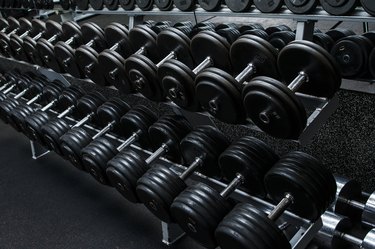
Teens can benefit from a strengthening program, however many are unsure of the right weight training routines for a 13 year old boy or girl. The newest research provides a clear picture on how much of a dumbbell lift a teen should do to safely increase strength, endurance and tone.
Tip
A teen should lift enough weight that after six to 12 repetitions using proper form, the muscle is fatigued. If you can easily do 12 repetitions, then move up in weight.
Video of the Day
Right Age for Weight Lifting
Kids can safely start weight training before they hit the teen years, however once they reach puberty, they have the right hormones to start building muscle mass. The American Council of Exercise says that kids can start lifting weight as soon as they can safely follow directions, which is usually around seven or eight. Even though they won't see the muscle mass development until they reach their teen years, they will see an improvement in strength and endurance.
Video of the Day
Weight Lifting Benefits for Teens
If your teen wants to excel at sports, then he or she should consider hitting the gym. Weight training for teens has many benefits, including improved athletic performance and strength, says a May 2016 study in Frontiers in Physiology.
In addition to improved athletic performance and strength, a July 2017 study in the Translational Pediatrics journal showcased even more benefits of weight training for adolescents, including:
- Lower rates of sports-related injuries
- Decreased risk of fracture
- Increased bone strength
- Improved self esteem
To clear up one unfounded rumor, according to the study, weight lifting as a teen will not stunt growth or affect growth in any way.
Read More: Why Exercise is Important For Teenagers
Weight Training Routine for Teens
How much of a dumbbell lift should a 13-year-old do? There isn't one general number that works for every teen, as there a number of factors in play. According to the American Council on Exercise, you should use enough weight that after six to 12 repetitions, you should be tired by the final rep, while maintaining proper form. If you aren't fatigued, then move up to the next weight.
For example, start with a two or three pound dumbbell when doing a bicep curl. If you can easily do 12 without pushing yourself to get those last few reps in, then the weight is too light and you need to move up to the five pound weight. Even though you should be tired and pushing yourself for those last reps, you should also be maintaining proper form. If you can't and you feel like you are arching your back or trunk, then the weight is too heavy.
The right weight training routine for a 13-year-old boy or girl requires a warm up for 10 to 15 minutes with aerobic exercise, such as the treadmill or stationary bike, before lifting weights to warm up the muscles. The teen should do six to 12 reps, limiting it to two sets of each exercise. Alternate days, focusing on two to three sessions a week to strengthen muscles without injury.
Are Dumbbells Best for Teens?
Dumbbells are a great way to start weight training. However, the benefits of weight lifting aren't just limited to free weights. The Translational Pediatrics study showed that weight machines, resistance tubing and barbell lifts are just as effective as free weights or dumbbells, as long as proper form is being used.
It is important to keep in mind that smaller teens may not fit in the weight machines properly, so if that is the case, stick to dumbbells or resistance bands or tubing until the teen is big enough for proper form.
Preventing Injury When Lifting
Trunk and back injuries are the most common weightlifting injuries among kids and teens, reports Translational Pediatrics, however they are easily preventable. Make sure the teen does core or abdominal strengthening exercises, such as the plank, to give them the foundation to prevent injury.
In addition, it is important that the weight used when lifting is not so heavy that they are compensating with their back. A trainer or coach can ensure that proper form is being used. Lastly, teens need to pay attention to their bodies. If they are feeling joint or muscle pain, stop and decrease the weight or have a trainer evaluate their form.
Read More: How to Lose Stomach Fat for Male Teens
- Stanford Children's Health: "Weight Training for Teens"
- American Council on Exercise: "Strength Training for Kids: A Guide for Parents and Teachers"
- Frontiers in Physiology: Effects of Resistance Training in Youth Athletes on Muscular Fitness and Athletic Performance: A Conceptual Model for Long-Term Athlete Development"
- Translational Pediatrics: Resistance training for children and adolescents"
- American Council on Exercise: "How to Select the Right Intensity and Repetition for Your Clients"
- Mayo Clinic: "Is Weight Training Safe for Teens?"
- Kids Health: The Musculoskeletal System